Introduction
The sun is the centre of gravity of our solar system. It is the energy supply for our planet. It is the energy emitted by the sun that allows, directly or indirectly, the existence of life on earth.
The energy emitted by the sun is 3.72 X 1020 MW, which equates to a radiative power of 63 MW per m² of its surface. At the mean distance between earth and sun, this radiation reaches the outside of the earth’s atmosphere with an intensity of 1.367 kW falling onto a 1 m² surface oriented normally to the sun’s beams. This is called the Solar Constant.
The sun’s outermost and relatively thin 400 km layer is called the Photosphere and has a temperature of approximately 5,770 Kelvin. This is the layer that emits the spectrum of radiation which is visible to the human eye and is termed ‘light’.
The mean distance between earth and sun is approximately 150 million kilometres. The earth reaches the point nearest to the sun (Perihelion - 147 million kilometres) in the beginning of January each year. After 6 months, on the 4th of July, it reaches the farthest distance from the sun (Aphelion - 152 million kilometres). This means that, due to these different distances, the direct solar radiation reaching the earth’s atmosphere is 7% more intense in January than it is on the 4th of July (see illustration below). However, these differing distances between the earth and the sun only have a minor effect on the seasonal temperatures on the earth.
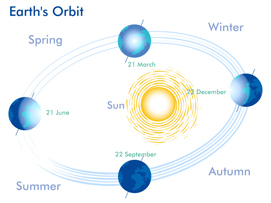
The Atmosphere
The earth’s atmosphere has a considerable influence on the intensity of solar radiation reaching the ground. Its height is approximately 70 to 80 km and it mainly consists of Nitrogen (~78%) and Oxygen (~21%). About a dozen other gases plus water vapour together make up only 1% but can have a large effect on climate and the environment, for instance ‘greenhouse gasses’ such as Methane and Carbon Dioxide.
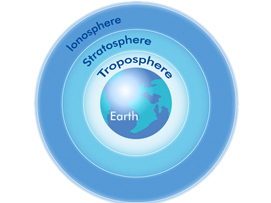
Illustration 2: The Atmosphere
The individual layers of our atmosphere differ from each other and are therefore classified by specific terms as shown in Illustration 2.
The bottom layer is named the Troposphere. It is the most cloudy layer and reaches up to the Tropopause. The Tropopause is the boundary between the Troposphere and the Stratosphere. It is located between the heights of 11 km and 16 km depending on the location above the earth and the atmospheric conditions.
The Stratosphere is nearly cloudless due to its very low air humidity. The ozone layer is primarily located in the stratosphere at altitudes of 15 to 85 km. Above the Stratosphere is the Mesosphere, beginning at a height of approximately 50 km above the ground surface. Above the Mesophere is the Ionosphere, which is also known as the Thermosphere, and reaches up to height of around 640 km. Beyond the Ionosphere begins the Exosphere which is the outer boundary and reaches up to 9,600 km. Beyond this is inter-planetary space.
Half of the complete mass of our atmosphere is situated in the first 5 to 6 km above the ground surface. When passing through the atmosphere extra-terrestrial solar radiation is reduced by scattering and absorption caused by air molecules, aerosol particles, water droplets and ice crystals in clouds.
Scattering of solar radiation takes place within the whole spectral range. However, there are different ways in which the scattering can occur:
Scattering by water droplets and/or ice crystals in clouds relatively evenly across the whole spectral range;
Scattering by molecules (Rayleigh-Scattering), predominantly of radiation at shorter wavelengths;
Scattering by aerosol particles (Mie-Scattering) at wavelengths dependant upon the particle size and distribution.
Gaseous molecules and aerosols cause a relatively high absorption of solar radiation. Scattering and absorption in the atmosphere affect the spectral balance of the solar radiation reaching the ground.
Illustration 3 shows the typical spectrum of solar radiation at sea level in ideal atmospheric conditions.
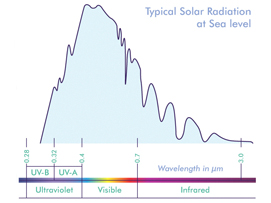
Illustration 3: Solar Radiation at Sea Level Variations of air pressure and temperature within the atmosphere influence absorption and therefore affect the spectrum at sea level and at different heights above sea level.
The Earth
The amount and type of radiation falling on the ground surface depends upon the changing characteristics of the atmosphere. Other important factors are the size of our planet and its location within space, but the crucial factor for the amount of radiation being absorbed by the earth, or reflected from it, is the composition of the ground surface.
The sun provides over 99.98% of all energy to the earth’s surface, the rest is internal geothermal energy. This results in an average surface temperature of 14°C, although extreme variations may occur locally and temporally. The highest temperature measured was 57.3°C in Libya and the lowest was - 89.2°C in Antarctica.
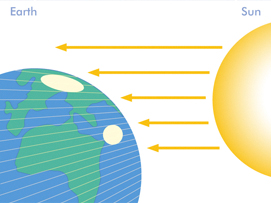
Illustration 4: Angle of Incidence of Solar Radiation The angle of incidence of the solar radiation is changing continually as the earth is circling around the sun and also spinning around its own axis. The ratio of radiation intensity and angle of incidence may be described as a cosine function, which is also called Lambert’s law (see Illustration 4).
The 23.5º inclination of the earth’s axis also has an influence as can be seen from Illustration 5. The all-important factor is the change of the angle of incidence during the different times of the day.
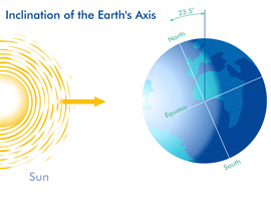
Illustration 5: Inclination of the Earth
The earth is not a flat disk. It is almost spherical in shape and gravitational force binds the atmosphere like a shell. The intensity of the solar radiation at a point on the surface is therefore influenced by the curvature of the surface and the effective thickness of the atmosphere.
The solar radiation reaches its highest intensity when the sun is at its zenith and the angle of incidence is 90° and the thickness of the atmosphere is at its minimum. The lower the sun’s position is in the sky the more atmosphere the radiation must pass through, and so more radiation is scattered and absorbed by the atmosphere and less radiation reaches the ground surface.
The effective thickness of the atmosphere is called the Atmospheric Depth. Just above the horizon the Atmospheric Depth is approximately 11 times larger than at the shortest path, at 90º (solar zenith), see Illustration 6.
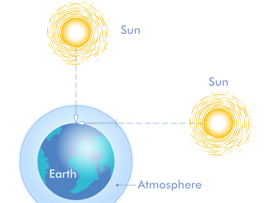
Illustration 6: Atmospheric Depth
The effects of solar radiation are also influenced by the composition of the ground surface. It is not difficult to understand that a surface covered with snow reflects more radiation than one covered with trees or with black rock. The fraction of the incident solar radiation that is reflected by the surface is called the Albedo.
Continue to read more about solar radiation and the measured parameters in meteorology.
Source: Solar Radiation measurement by Reinhold Rösemann